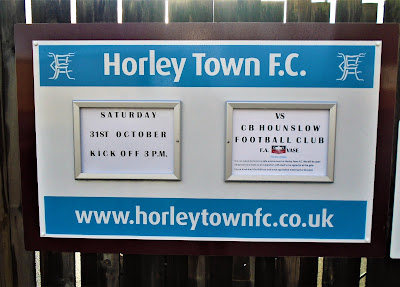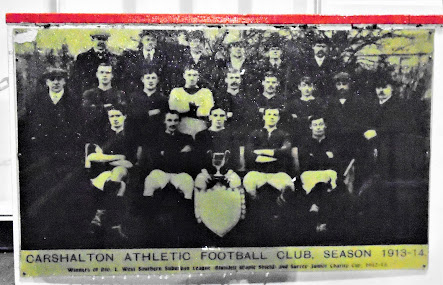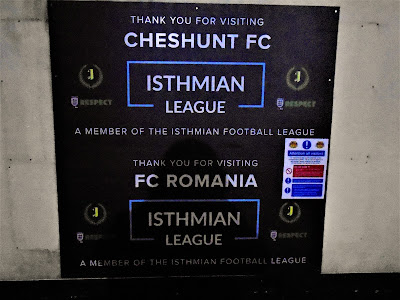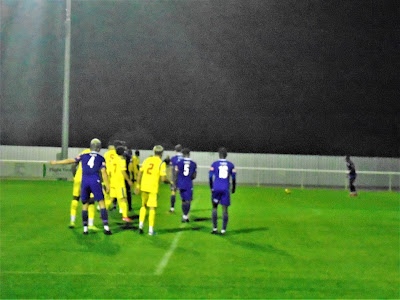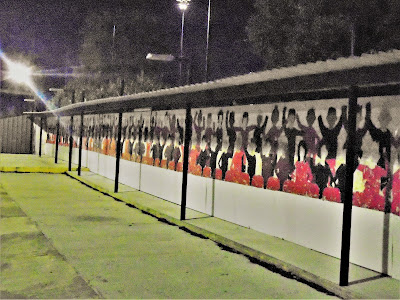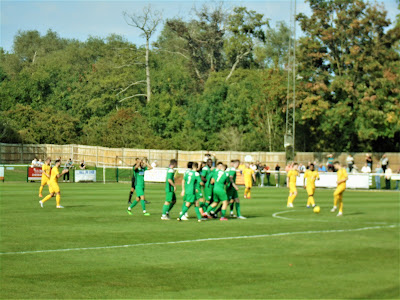Horley Town 5 CB Hounslow United 1 (FA Vase first round)
The New Defence, 31 October 2020
The New Defence, 31 October 2020
When spectators were allowed back into non-League games, I'd planned to blog about every one I watched. That didn't happen: I soon found that in the absence of live music or theatre, with my reluctance to visit socially-distanced cinemas in a face mask and my friends' shared unwillingness to meet in pubs or restaurants, football became my main social activity. At times I went to two, three or even four matches a week, finding it was the only thing that offered any sense of surprise, any opportunity to visit places I normally wouldn't, even if those places were no more exotic than Carshalton or Leatherhead. I didn't always have enough to say, about the club(s), the matches or the experiences, to make a long piece worthwhile, and as I predicted after my second game, at Balham, this project started to feel like a bit of a chore: a lot of effort for not much reward in terms of readership, money or creative development.
I've covered a lot of ground: besides the ten games written up here, I've been to Wingate & Finchley, Haringey Borough, Tooting & Mitcham, Corinthian-Casuals, Hornchurch, Cray Valley Paper Mills and Cray Wanderers. The latter provided one of my favourite moments in a season where I've lamented the lack of any familiarity when Merstham, bottom of the Isthmian League Premier Division, brought on their player-coach - 48-year-old ex-Fulham striker Barry Hayles, who got booked for screaming at the referee in his team's 6-0 defeat. Apart from that throwback to 2001 - and the days when high-level players wound down by dropping through the leagues - there hasn't been much to say that a conventional report wouldn't do. Hence not writing up the best game I've seen this season: Colliers Wood United vs. Redhill, when Redhill went 3-0 up in the first half, Colliers Wood pulled back two goals just after half-time and then equalised after 70 minutes, Redhill grabbed a late winner and then the home team had a man sent off.
I didn't write up my second trip to Horley Town, either, for a 4-0 win over East Preston in the Southern Combination in which the clarets looked a genuinely strong side (and far improved on the first time I saw them this season). Having seen their excellent start to the season, I felt they might be a good bet for the FA Vase, for clubs in tiers 9-11 of the pyramid, and planned to see them at CB Hounslow United in the first round after they won their qualifying tie at Punjab United with a last-minute goal. I wanted to add Hounslow to my list of clubs visited, but the tie was switched to Horley - I didn't know why, but my friend Chris and I decided to go anyway. In the week, I saw Clapton CFC were playing Stonewall, politically a far more intriguing prospect between two teams I hadn't yet seen, but despite that and the torrential rain, I decided to stick with my plan and drag myself back to the New Defence. A good decision, it turned out, as the Clapton game got called off after a late pitch inspection, while Horley's went ahead.
Chris and I ate together in a pub - illicitly, I think, as Horley is in Tier 1 but we'd come from London, in Tier 2, and apparently we take our restrictions with us. Nobody asked, so we sat and checked the result from Norwich's early kick-off against Bristol City and then talked about politics: our mutual loathing of Sir Keir Starmer QC, and the growing inevitability of another lockdown, after restrictions were introduced in Belgium, France, Germany, Greece and Spain.
Would it mean the end of our football-watching? It has mostly felt low-risk, with SARS-CoV2 not persisting in well-ventilated outdoor areas for long, but lately, as the infection and death rates have cshot back up and London was put into Tier 2, I've been a bit more anxious, both at games with larger crowds (like the 600 at Corinthian-Casuals v. Leatherhead last weekend) and on busy trains to get to them. As we walked past the River Mole to The New Defence, the weather cleared, and we got a nice afternoon for what we suspected might be our last trip for a while.
Almost immediately, my decision to come, and my hunch that Horley could hope to win the FA Vase, were vindicated. Left-back Ryan Brackpool headed home from a corner on 12 minutes, and Horley soon got two more, with new signings Lewis Pearch (who scored for Kingstonian in their FA Cup win over Horley) and Mario Quiasacca linking up brilliantly with forwards Adam Grant and Kofi Quartey. The Clarets were dominant, forcing several good saves from CB Hounslow goalkeeper Sam Bersey and hitting the post; the game didn't have much tension, especially after Smith scored a penalty early in the second half and then Quartey made it 5-0 a few minutes later, but there was a genuine feel-good factor among the 100 or so fans, and nothing like that mounting sense of dread I'd felt back in March, including at the Spurs game I went to, and which had returned over the last few weeks. I told Chris I'd planned to come back for the next lockdown, having spent the first one here, and hoped I'd be able to watch Horley Town during my stay.
Horley conceded in injury time, but could easily have won by more than 5-1. We celebrated with a quick trip to the clubhouse bar, full of old team pictures like the one above, and walked through the churchyard back to the station, checking our phones for the announcement on the new measures planned for 5pm. That was delayed by more than two hours, meaning Chris and I had parted company by the time the Prime Minister and his scientists clarified what had been leaked to their client journalists while we were watching the match.
'Clarified' is a difficult word to use of any of this government's communications, delivered as they are to an imagined audience of idiots through a public sphere that has been shot to shit, but this is almost certainly the last game I'll see for at least a month, with no-one allowed to meet more than one other person outdoors until early December. "Elite" sport will continue, we were told, without fans but doubtless continuing to be put on pay-per-view at exorbitant prices - I hope fans keep boycotting it, like the Newcastle United supporters who gave their £15 to local food banks instead. Chances are I'll watch Norwich out of boredom if nothing else, but expect to find it just as miserable as in June; I'm not expecting to go back to Carrow Road this season, and now I have my doubts about next year as well, and really, I'd much rather go to The New Defence than sit alone through another soulless, sterile spectacle of a fanless football match in any case. Fingers crossed that Horley Town and other clubs of their size can welcome people back soon - and that if my prediction proves accurate and they make it to Wembley, that I am able to attend.

